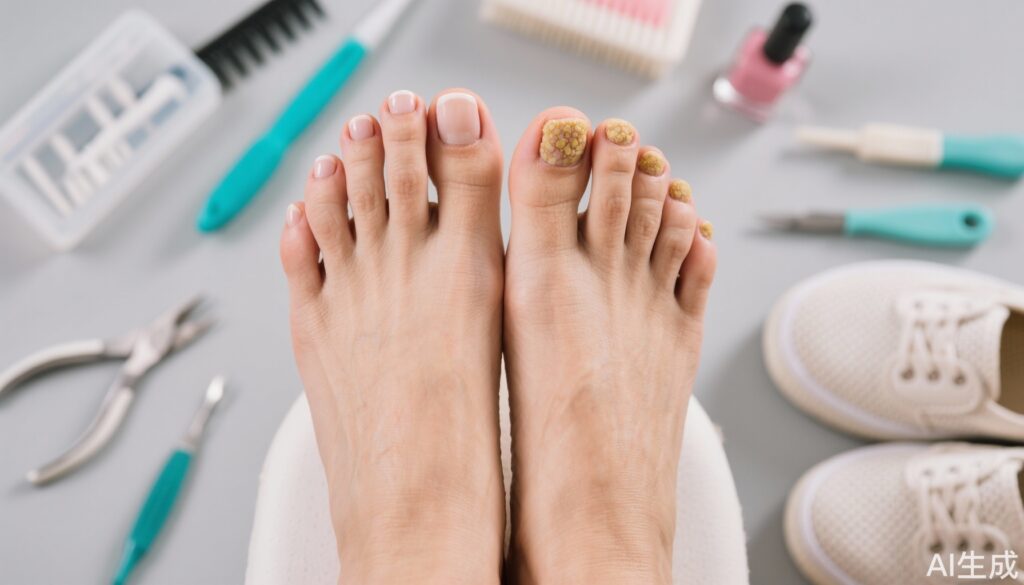Introduction
Many people dismiss changes in their nails as merely cosmetic issues, but alterations like thickening, yellowing, and brittleness can indicate a common yet persistent condition known as fungal nail infection or onychomycosis, often called “gray nail.” What starts as a small white spot can gradually change the entire nail’s appearance and structure, causing discomfort and even pain. This article explores what fungal nail infection is, who is most susceptible, how to spot it, treatment approaches, prevention strategies, and common misconceptions.
What Is Fungal Nail Infection?
Fungal nail infection, medically termed onychomycosis, is a condition caused by dermatophytes (skin fungi), yeasts, and non-dermatophyte molds infecting the nail plate or nail bed. The invasion of these fungi leads to nail discoloration, thickening, deformity, brittleness, and sometimes pain, substantially affecting quality of life. Importantly, it is not just a cosmetic issue; fungal nail infections are progressive, contagious, and if untreated, can spread to other nails or family members.
Who Is Most at Risk?
Not everyone develops fungal nail infections equally; certain populations are particularly vulnerable:
1. Older Adults: Studies indicate people over 60 years old have a 3-4 times higher chance of contracting fungal nail disease compared to younger individuals.
2. People with Diabetes: High blood sugar levels create a favorable environment for fungal growth and complicate infections.
3. Individuals with Weakened Immunity: Patients with HIV, organ transplant recipients, or those on long-term immunosuppressive therapy are at higher risk.
4. Occupational Exposure: Athletes, military personnel, miners, and homemakers frequently exposed to moist environments have increased susceptibility.
5. Those with Existing Foot Fungal Infections (Athlete’s Foot): These infections serve as fungal reservoirs that can easily spread to nails.
6. Regular Manicure Enthusiasts: Use of inadequately sterilized manicure tools and aggressive nail surface alterations raise infection risks.
7. Individuals Wearing Inappropriate Footwear: Tight, non-breathable shoes and socks create warm, moist environments conducive to fungal proliferation.
Recognizing Fungal Nail Infection: More than Just “Gray” Nails
Many mistakenly believe fungal nails are simply gray in color. In reality, clinical presentations vary:
– Distal Lateral Subungual Type (Most Common): Nail edges or tips turn yellow and thick, lifting from the nail bed.
– White Superficial Type: White spots or scales appear on the nail surface.
– Proximal Subungual Type: Starting near the nail root, often seen in immunocompromised individuals.
– Total Dystrophic Type: Entire nail is destroyed, thickened, brittle, and discolored yellow-brown.
It’s crucial to note that nail changes may also stem from psoriasis, lichen planus, eczema, or other conditions and not all nail discoloration signifies fungal infection. Therefore, medical examination and fungal microscopy in dermatology clinics are essential for accurate diagnosis.
Treatment Strategies: Effective Approaches to Clear Fungal Nail Infection
Many patients attempt home remedies or over-the-counter treatments with limited success. Effective management depends on the extent and severity of infection, with several therapeutic options:
1. Topical Antifungals: Suitable for mild infections affecting less than 50% of the nail. Examples include:
– 5% Amorolfine lacquer, applied once or twice weekly, has good penetration.
– 8% Ciclopirox lacquer, used daily, forms a protective film.
2. Oral Antifungals: Recommended for moderate to severe infections:
– Terbinafine, effective against dermatophytes, usually given for 6-12 weeks.
– Itraconazole, administered in pulse therapy, has enhanced effectiveness against yeasts.
3. Combination Therapy: Using topical and oral treatments simultaneously increases cure rates and reduces recurrences.
4. Laser Therapy: A newer, non-invasive, painless modality available for patients unsuitable for systemic drugs.
The Importance of Treatment Adherence
One major obstacle to successful treatment is premature discontinuation of therapy. Due to the slow growth of nails, complete replacement takes months:
– Fingernails require 3-6 months.
– Toenails require 6-12 months.
Patients often stop treatment early because visible improvements appear slowly, but to ensure a cure, therapy must be continued until the healthy nail fully regrows.
Prevention: Maintaining Healthy Nails
Preventing fungal nail infections is paramount. Recommended practices include:
1. Keep Feet Dry: Thoroughly dry feet, especially between toes, after washing. Alternate shoes to let them dry completely.
2. Wear Breathable Shoes and Socks: Choose cotton socks and leather or fabric shoes. Avoid prolonged use of rubber or tight shoes.
3. Protect Public Areas: Use slippers in pools, gyms, and public showers, and avoid sharing socks, shoes, or nail tools.
4. Proper Nail Care: Avoid cutting nails too short or damaging surrounding skin. Ensure manicure tools are properly disinfected.
5. Treat Accompanying Fungal Diseases: Simultaneously address athlete’s foot or other fungal infections to prevent cross-contamination.
Common Misconceptions and Truths about Fungal Nail Infection
| Misconception | Truth |
|———————————-|————————————————————————————————|
| Only a cosmetic problem | Fungal infection can spread, cause pain, and secondary bacterial infections. |
| Oral antifungals harm the liver | Newer medications are safer, with liver monitoring by doctors during treatment. |
| Stop medication when symptoms vanish | Full course needed until healthy nail grows out to prevent recurrence. |
| Fungal nail infections are incurable | With proper treatment, cure rates reach 80-90%. |
Special Considerations for Vulnerable Patients
Diabetic patients are at special risk. Fungal nails can lead to secondary bacterial infections, contributing to diabetic foot ulcers and, in severe cases, amputation. Immunosuppressed individuals (post-organ transplant, HIV-positive) may develop deep fungal infections that threaten life. Any abnormal nail changes in these patients warrant immediate medical consultation.
Patient Scenario: Emily’s Journey with Fungal Nail Infection
Emily, a 65-year-old retired teacher, noticed a small white spot on her toenail after a summer manicure. Over six months, her toenail thickened, turned yellow, and became brittle. Initially ignoring it as cosmetic, the nail eventually caused discomfort, prompting her visit to a dermatologist. Diagnosis: onychomycosis. Emily was prescribed a combined therapy of oral terbinafine and topical amorolfine lacquer, with instructions to adhere for at least 9 months. She diligently followed her regimen, gradually seeing healthy nail growth. She also adopted preventive habits, such as proper foot hygiene and avoiding tight shoes. Today, Emily enjoys healthy nails and advises her friends against ignoring early signs.
Conclusion
Fungal nail infections are a common, often underestimated medical condition that extends beyond mere cosmetic concerns. Awareness about at-risk groups, recognition of varied clinical features, timely and appropriate treatment, along with preventive practices, are key to effective management. Avoiding misconceptions and adhering to prescribed therapy improves outcomes significantly. Individuals, especially those with underlying conditions, should seek professional care promptly to protect nail health and overall wellbeing.
References
– Gupta AK, et al. Onychomycosis: epidemiology, diagnosis, and management. Expert Opin Pharmacother. 2007;8(14):2305-18.
– Ghannoum MA. Clinical evidence on dermatophyte infections. J Am Acad Dermatol. 1994;31(5 Pt 2):S2-10.
– Elewski BE. Onychomycosis: pathogenesis, diagnosis, and management. Clin Microbiol Rev. 1998;11(3):415-29.
– Scher RK, et al. Onychomycosis: diagnosis and management. J Am Acad Dermatol. 2002;47(5):575-86.
– Mertin D, Arrese JE. Oral terbinafine and itraconazole for the treatment of onychomycosis. Curr Opin Infect Dis. 1998;11(2):143-50.
– Gupta AK, Versteeg SG, Shear NH. Treatment of Onychomycosis. Dermatol Ther. 2017;7(1):17-27.


